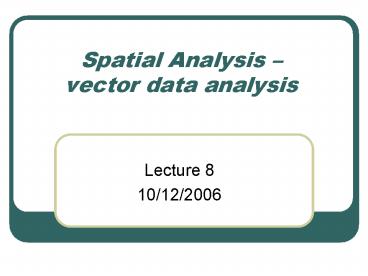Spatial Analysis vector data analysis - PowerPoint PPT Presentation
1 / 21
Title:
Spatial Analysis vector data analysis
Description:
To create a new subset from the input (features and attributes in a feature ... discovered in several fields of study, including climatology and geography. ... – PowerPoint PPT presentation
Number of Views:183
Avg rating:3.0/5.0
Title: Spatial Analysis vector data analysis
1
Spatial Analysis vector data analysis
- Lecture 8
- 10/12/2006
2
Spatial Analysis tools in ArcToolBox
Shapefile Feature class
Coverage
Raster
3
Details
Coverage
Shapefile and feature class
Raster
4
Extract
- To create a new subset from the input (features
and attributes in a feature class or table) based
on spatial intersection or an attribute query. - Clip
- Select
- Split
- Table select only
5
Clip
- ff
6
Select
7
Split
8
Overlay
- Joining two existing sets of features into a
single set of features to identify spatail
relationships between the input features. - Erase
- Identify
- Intersect
- Symmetrical difference
- Union
- Updata
9
(No Transcript)
10
(No Transcript)
11
(No Transcript)
12
(No Transcript)
13
(No Transcript)
14
(No Transcript)
15
Proximity
- Identify features that are closest to one
another, calculate the distances around them, and
calculate distances between them. - Buffer
- Multiple ring buffer
- Near
- Point distance
16
(No Transcript)
17
(No Transcript)
18
(No Transcript)
19
(No Transcript)
20
(No Transcript)
21
How to form Thiessen polygons
- Also known as 'Voronoi networks' and 'Delaunay
triangulations', Thiessen polygons were
independently discovered in several fields of
study, including climatology and geography. They
are named after a climatologist who used them to
perform a transformation from point climate
stations to watersheds. - Thiessen polygons can be used to describe the
area of influence of a point in a set of points.
If you take a set of points and connect each
point to its nearest neighbour, you have what's
called a triangulated irregular network (TIN). If
you bisect each connecting line segment
perpendicularly and create closed polygons with
the perpendicular bisectors, the result will be a
set of Thiessen polygons. The area contained in
each polygon is closer to the point on which the
polygon is based than to any other point in the
dataset.































